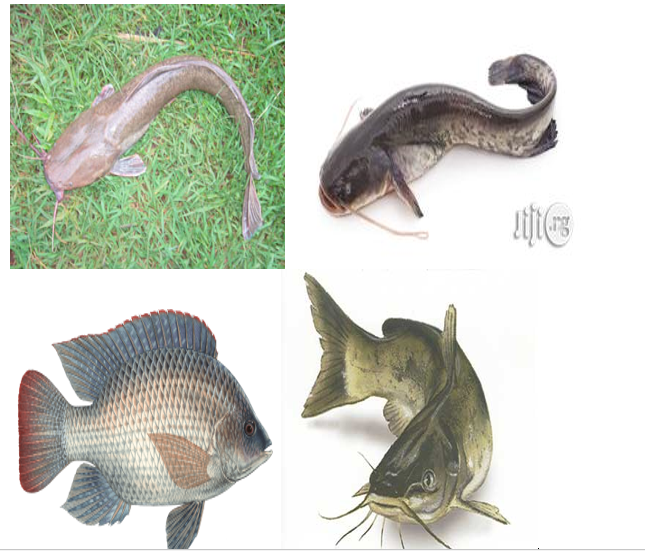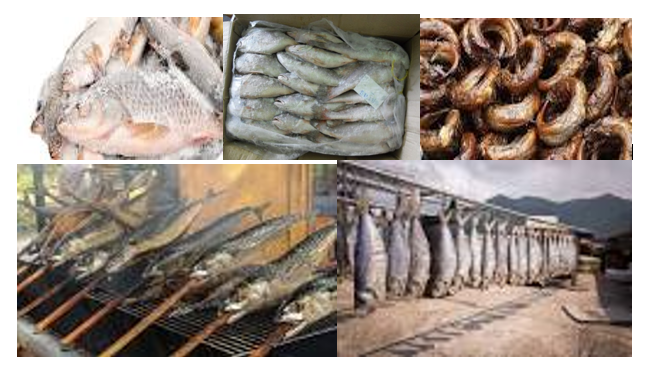Back to: AGRICULTURAL SCIENCE SS3
Welcome to class!
In today’s class, we will be talking about fish farming. Enjoy the class!
Fish Farming

Fish farming (pisciculture) involves raising selected fish species commercially under scientifically controlled conditions in enclosed water bodies such as ponds, lakes etc. where they live, feed, breed and are harvested for man’s use. Common fish species reared commercially includes salmon, tilapia, catfish, crab etc.

Fishery: This is the study of fish and other aquatic animals. Fish live in water bodies (e.g. ponds, lakes, oceans, seas, rivers), respire with the gills and possess fins for swimming. They are cold-blooded animals because of their body temperature changes with a change in the environment.
Evaluation
- Define fishery.
- Mention five examples of cold-blooded animals.
Importance of fish farming
- Food: Fish and other aquatic organisms are used mainly as human food. Fish flesh is regarded highly for containing first-class animal proteins, vitamins and many mineral salts and other chemical substances that are needed to keep the human body healthy and strong. The flesh of fish, crabs, prawns and squid is very soft and good to eat. Fish and turtle eggs are also commonly eaten. Fish eggs which are salted and prepared for eating are called caviar.
- Leather: The skin of cartilaginous fish such as sharks is tough and covered with small, sharp spines. It is sometimes dried and specially treated to produce very special leather called shagreen. Crocodile and turtle skins also make very good leather for handbags, wallets, belts and shoes.
- Polishing material: Dried fish skin or shagreen is sometimes used like glass-paper for polishing surfaces.
- Ornaments: The scales of fish are sometimes to make artificial pearls which can be worn as beads. Oysters contain pearls which are polished and worn as jewellery.
- Soap and medicine: The oils obtained from fish, whales and turtles are used as food and also for the manufacture of medicines and soap. Cod-liver oil is a very popular item consumed by many people as a food supplement.
- Animal feed: Many fish and parts of fish which are not eaten by humans are processed into fish meal and used in the manufacture of livestock feed.
- Building: Shells of oysters and periwinkles are sometimes mixed with cement and sand for building houses. The periwinkles make the wall stronger and highly attractive.
- Glue and fertilizer: Fishbones are also used for the manufacture of glues and fertilizers.
- Income
Preservation of fish
This process involves keeping harvested fish long enough to ensure they maintain a very level of freshness before consumption. Preservation prevents spoilage, injury or destruction and this keeps the fish in edible condition for a long time. Harvested fish if not well stored will get spoilt and cause great loss to the farmer hence the need to elongate its shelf life. Preservation can be carried out in any of the following ways:
- Salting/Curing: Application of salt in the fish which prevents the growth of spoilage organisms should be practised. A well-salted fish can stay long without spoilage provided the fish was originally fresh.
- Smoking: This is the drying of fish over a fire. This reduces the moisture content and improves the taste and flavour of the fish. It also gives colour to the fish. The fish must be constantly reheated and aerated and kept away from flies to make it fit for consumption.
- Canning: This involves the storage of the processed and consumable fish in cans under special conditions for future consumption and sealing the cans so that air cannot pass into them. For example Geisha, Sardine etc.
- Sun Drying: This involves the drying of fish using the direct heat from the sun called solar energy. Here, the fish can only be stored for a short time. It is common in Northern Nigeria. It is simple and slow. It is not easily practised in Southern part because of high humidity.
- Freezing/Refrigeration: This is called chilling. This involves the use of cold storage like deep freezers and refrigerators to store fish over a long time at very low temperature, where bacteria become inactive until the fish are needed. Storage can be done as long as possible provided the system is on.
- Conversion to feed meal: Parts of fish (especially parts that are damaged or not good for human consumption) are dried and ground into a powder known as fish meal. This is used as essential ingredients of livestock feeds. Fish meal is useful to farmers in raising livestock.
- Roasting: This involves burning fish over a fireplace for a short moment.
- Icing: this involves lacing ice block over-harvested fish in a container this method is temporary.
- Steam cooking: this involves cooking harvested fish over hot steam.
- Irradiation: this involves the treatment of fish non-harmful dosage of ionizing radiation this helps to slow down or halt spoilage by retarding enzymatic action and or destroying microbes.

Some of the aims of preservation
- To retain the quality and quantity of fish.
- To increase the shelf life of the food.
- To develop different types of fish food.
- To maintain all season supplies.
- To avoid spoilage caused by micro-organism.
Processing of fish
Processing is the changing of food material fish from one form to another. It involves the removal of inedible part and changing the fish from one form into a preservable form. These are examples of things removed during processing gut, scales, gills, bones, and fins. By product of fish processing includes fish meal, fish scale, cod liver oil and fish skin.
Fish harvesting
Harvesting is the collection of fish from a pond for consumption, preservation or for sale.
Methods of fish harvesting
Fishing methods involve the use of different techniques or equipment used in harvesting fishes.
- Netting: This involves the use of nets to catch fish. Examples of nets include gill nets, clap net, trawl net, scoop net, beach seines, dragnet, drifting or floating nets, cast nets etc. Nets are woven to various sizes and thickness and are thrown into the water to catch fish. Each type is used differently.
- Nets: These are made from fine cotton or nylon, the thread is lowered into the water. The small weight made of lead is attached to the edges of the net which help them to sink to the bottom of the water. When the net is pulled up, it encloses many fishes which are then caught between the holes called MESH of the net.
- Trapping: This is the setting of traps to catch fish. Gears made from ropes or raffia are woven into various sizes for capturing fishes. The traps are set along with water courses and any fish that comes into them is trapped. There are many types of fish traps which can be made either from bamboo, canes, raffia, oil palm or coconut palm fronds or wire and wire mesh.
- Hooks and Lines: This involves the use of hooks tied to strings then set along a watercourse. The hooks are baited with food to attract the fish.
- Use of Ultrasonic: This is an instrument that makes sound in the water to attract fishes. Other means of harvesting like a net can later be used to pack them.
- Electrofishing: This is the use of electric field connected to the water to make the fishes become electrocuted. It can only be used for the total harvesting of fish.
- Impaling: This involves the use of spears or harpoons or any sharp objects (wounding equipment) to attack and catch big fishes e.g. shark.
- Pots and Gourds: Some fishermen who fish in ponds and shallow lake, place clay pot and gourds in water to catch the fish when fish enter them.
- Screen or barriers: Screens made with bamboo, raffia or oil palm fronts are used to enclose portions of shallow water. When fish enters the trap/enclosed areas at high tide, it cannot escape at low tide when water is reduced, hence they are collected.
- Fishing without equipment: Some aquatic animals can be caught without any kind of fishing equipment. They are picked up by hand, having driven to the mud and plants on which the water current attaches them. Examples are periwinkles, oysters, and clams.

Basic laws and regulations of fishery in Nigeria
Fishery regulations are rules and laws governing the exploitation and other practices of fishery resources.
The regulations include the following:
- Catch quota: This is a form of control in which fisherman is allowed to catch a specific quantity of fish or to regulate the number of fishers by issuing them permit or license at a specific amount.
- Close season: This is a regulation in which fishing is not permitted to take place for a given period. This helps in making the younger fishes grow and mature.
- Mesh size regulation: This involves the use of a standard size net or mesh so that only the matured fishes are caught thus leaving the younger ones to grow to adulthood before harvesting.
- Population control: This involves the process of cannibalism where fish types like catfish are made to eat other fish like Tilapia or early harvesting to prevent overpopulation.
- Regular stocking: This is the introduction of compatible species of fish to increase the population of fishes in the water.
- Prevention of vessels: No vessels (except canoes) is allowed to fish within the first two (2) nautical miles of the Nigerian Continental Shelf.
- Prohibitive use of explosives: The use of explosives is prohibited as this kills young as well as the old fishes.
- Ban on the use of poisonous chemicals: The use of poisonous chemicals like Gammalin 20 is prohibited as it kills both young and old fishes.
- Landing tax: Landing tax is used such that total catch and sizes of fishes are taxed at the site of landing.
- Allocation of fishing areas: Fishing areas are allocated to the individual’s fisherman to prevent interference with bigger fishing areas.
Weekend assignment
- Describe four methods of fish harvesting
- State four ways of preserving harvested fish
- Discuss briefly four fishery regulation (WASSCE 1993 question 8, 2009 question 8d, 2017 question 6c, 2008 question 8d, 2014 question 5e)
- Give the scientific names of three fish species commonly stocked in a pond (WASSCE 2009 question 7c)
- Give three reasons why fish farming is important (WASSCE 2013 question 7a)
- Enumerate two reasons why the use of chemicals is discouraged in fish harvesting (NECO 2018 question 8e)
In our next class, we will be talking more about Fish Farming. We hope you enjoyed the class.
Should you have any further question, feel free to ask in the comment section below and trust us to respond as soon as possible.

why is the use of chemicals discouraged in fish harvesting
It’s interesting